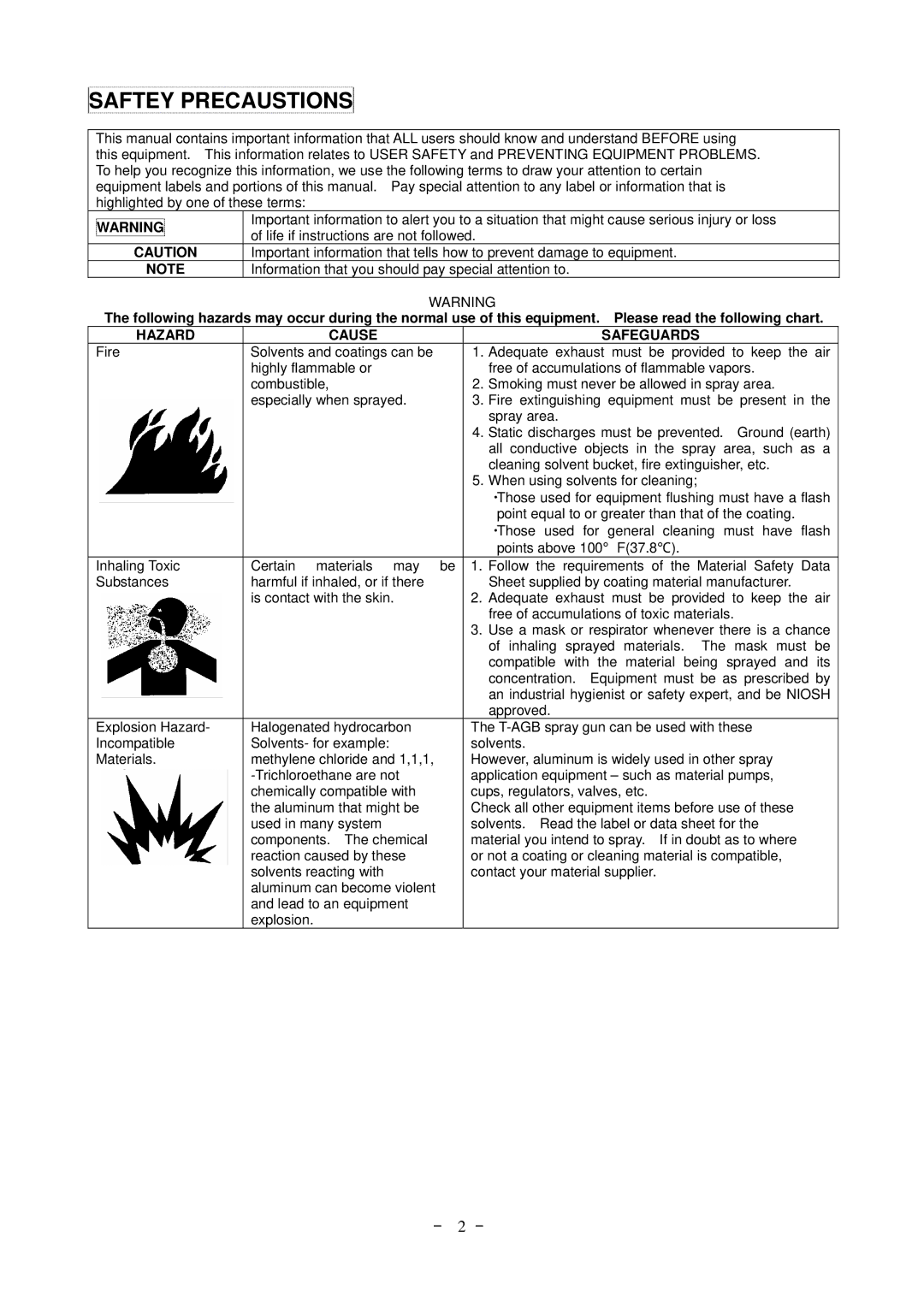
 SAFTEY PRECAUSTIONS
SAFTEY PRECAUSTIONS
This manual contains important information that ALL users should know and understand BEFORE using this equipment. This information relates to USER SAFETY and PREVENTING EQUIPMENT PROBLEMS. To help you recognize this information, we use the following terms to draw your attention to certain equipment labels and portions of this manual. Pay special attention to any label or information that is highlighted by one of these terms:
WARNING | Important information to alert you to a situation that might cause serious injury or loss | |
of life if instructions are not followed. | ||
| ||
CAUTION | Important information that tells how to prevent damage to equipment. | |
NOTE | Information that you should pay special attention to. | |
| WARNING |
The following hazards may occur during the normal use of this equipment. Please read the following chart.
| HAZARD |
| CAUSE |
| SAFEGUARDS | |
Fire |
| Solvents and coatings can be | 1. | Adequate exhaust must be provided to keep the air | ||
|
|
|
| highly flammable or |
| free of accumulations of flammable vapors. |
|
|
|
| combustible, | 2. | Smoking must never be allowed in spray area. |
|
|
|
| especially when sprayed. | 3. | Fire extinguishing equipment must be present in the |
|
|
| ||||
|
|
|
|
|
| spray area. |
|
|
|
|
| 4. | Static discharges must be prevented. Ground (earth) |
|
|
|
|
|
| all conductive objects in the spray area, such as a |
|
|
|
|
|
| cleaning solvent bucket, fire extinguisher, etc. |
|
|
|
|
| 5. | When using solvents for cleaning; |
|
|
|
|
|
| ・Those used for equipment flushing must have a flash |
|
|
|
|
|
| point equal to or greater than that of the coating. |
|
|
|
|
|
| ・Those used for general cleaning must have flash |
|
|
|
|
|
| points above 100°F(37.8℃). |
Inhaling Toxic |
| Certain materials may be | 1. | Follow the requirements of the Material Safety Data | ||
Substances |
| harmful if inhaled, or if there |
| Sheet supplied by coating material manufacturer. | ||
|
|
|
| is contact with the skin. | 2. | Adequate exhaust must be provided to keep the air |
|
|
| ||||
|
|
|
|
|
| free of accumulations of toxic materials. |
|
|
|
|
| 3. | Use a mask or respirator whenever there is a chance |
|
|
|
|
|
| of inhaling sprayed materials. The mask must be |
|
|
|
|
|
| compatible with the material being sprayed and its |
|
|
|
|
|
| concentration. Equipment must be as prescribed by |
|
|
|
|
|
| an industrial hygienist or safety expert, and be NIOSH |
|
|
|
|
|
| |
|
|
|
|
|
| approved. |
Explosion Hazard- |
| Halogenated hydrocarbon | The | |||
Incompatible |
| Solvents- for example: | solvents. | |||
Materials. |
| methylene chloride and 1,1,1, | However, aluminum is widely used in other spray | |||
|
|
|
| application equipment – such as material pumps, | ||
|
|
|
| |||
|
|
|
| chemically compatible with | cups, regulators, valves, etc. | |
|
|
|
| the aluminum that might be | Check all other equipment items before use of these | |
|
|
|
| used in many system | solvents. Read the label or data sheet for the | |
|
|
|
| components. The chemical | material you intend to spray. If in doubt as to where | |
|
|
|
| reaction caused by these | or not a coating or cleaning material is compatible, | |
|
|
|
| solvents reacting with | contact your material supplier. | |
|
|
|
| aluminum can become violent |
|
|
|
|
|
| and lead to an equipment |
|
|
|
|
|
| explosion. |
|
|
